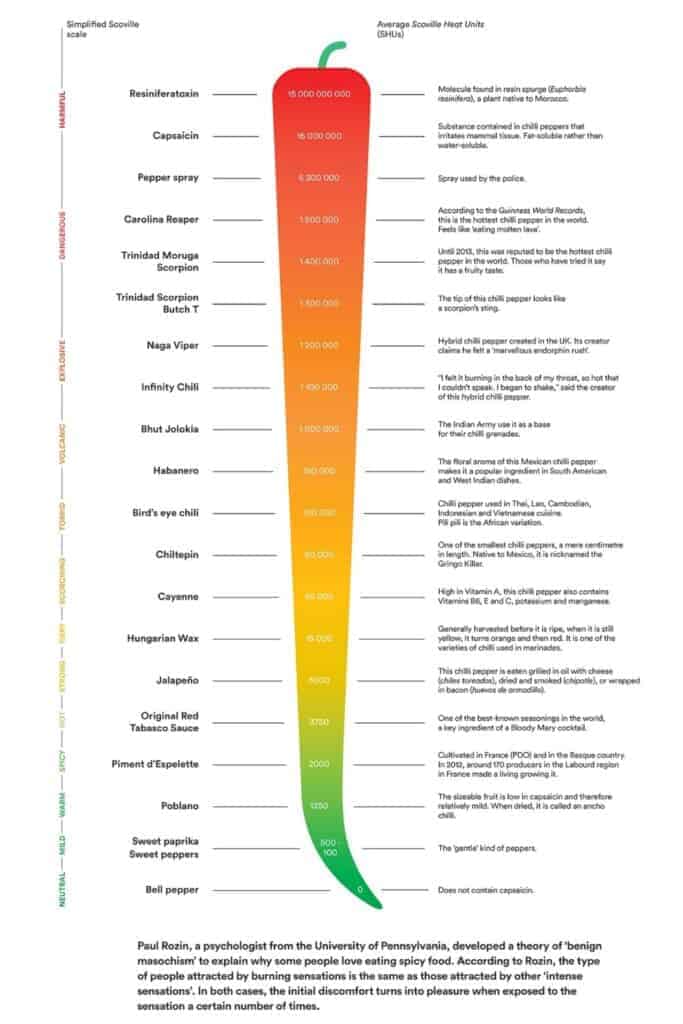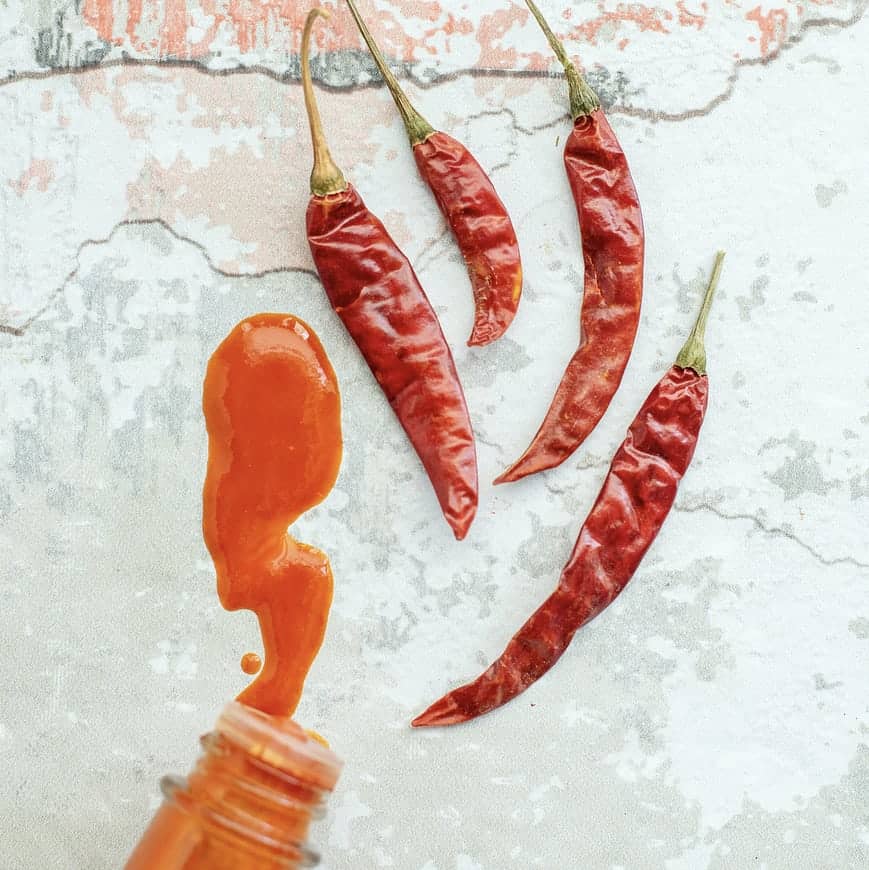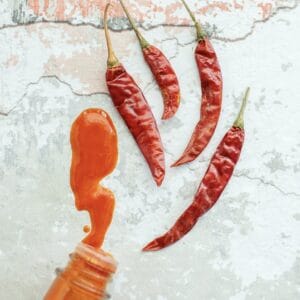This Homemade Hot Sauce recipe includes affiliate links. When I find a great product or service, I like to share it with my readers. Sometimes I use affiliate links so I can earn commission for my recommendations. Thank you for your support!
Chile de Árbol Hot Sauce Recipe
Up until recently hot sauce was an ingredient that I was perfectly happy to leave to the professionals. I always believed that homemade hot sauce was an undertaking ripe for failure…and pain. And I wasn’t entirely wrong. I experienced both while experimenting with this hot sauce recipe. Lucky for you, I carefully documented what not to do when making homemade hot sauce so you should fare much better!

What is Chile de Árbol?
Chile de Árbol, sometimes called a bird’s beak chili or a rat’s tail chili, is a moderately potent Mexican chili. These chili peppers are small – about 2-3 inches long and about the diameter of a string bean. I like to think that’s what earned them the nickname rat’s tail chili. Despite their small size, I feel I should caution you against the “moderately potent” designation. That’s their heat index according to the Scoville scale. I find them to be quite hot.

Finding the Motivation to Create A Hot Sauce Recipe
To be honest, I had never cooked with chiles de àrbol until fate brought us together on a recent camping trip. As you may know from my Ultimate Guide to Vegan Camping Recipes post, I like to scour farm stands and farmer’s markets for fresh vegetables, homemade breads and locally made condiments when I am out on the road. On our last trip we happened into Farm Runners, a small cooperative CSA in Hotchkiss, Colorado while making a food run.
I fell in love with this farm stand immediately. It was like someone took all of my favorite things and put them in there just for me. There were fresh local vegetables, heirloom tomatoes, bulk grains, non-dairy milks and miso paste (do you know how hard it is to find miso paste outside of an urban area?). While I was geeking out, my kids ordered breakfast which came with a small container of local hot sauce. As I often do, I was picking at their leftovers when I got my first taste of chile de àrbol hot sauce. It was so amazing that I went back and asked if I could buy several of the individual containers to take home. Lucky for me, they sold it in far more reasonable 5 oz containers. A prized possession.
A week later, I shared my hot sauce find with some friends on the back patio. I had carefully poured it from its plastic tub into a glass hot sauce bottle. A fatal error. My beloved hot sauce, placed too close to the edge of the table, met its end that night.
How to Make Hot Sauce
Since the hot sauce was a local product (local to a far-off destination) I wasn’t able to replace it. That’s when I decided it was time to learn how to make my own hot sauce. My passion for this chile de àrbol hot sauce had me on the how-to hunt the very next day.
As it turns out, hot sauce recipes are pretty simple. The chosen chili pepper carries the day. If it’s a dried chili, you simply need to rehydrate it before blending it into sauce (but see a few tips about this below). The chilies in hot sauce are rarely supplemented by more than a few other ingredients. In this case, I added only white wine vinegar, garlic and sugar.
How to Find Chiles de Árbol for This Hot Sauce Recipe
Finding the right chilis actually turned out to be far easier than I expected. My local grocery store (and quite possibly yours as well) carries a wide variety of chilies. You just need to look beyond the produce aisle. Often the less sought-after varieties are stocked as dried chilies. Of course, if you can’t find them in your local market, dried chilies are something that can easily be purchased online. Even Amazon carries them.
Respect the Chili Pepper’s Heat
Working with chili peppers, even dried chili peppers can be serious business. The heat, or “spice” as you might think of it, in a chili pepper is actually not a flavor registered by your taste buds. Don’t believe me? Remember the five taste sensations are sweet, sour, bitter, salty and savory (umami). There’s no spicy on that list. The human interpretation of spiciness is actually a chemical reaction caused by capsiaicin. Capsiaicin is a chemical compound found in the ribs and seeds of a chili pepper. It stimulates the nerves, registering in the body as pain. Now you know why pepper spray is so effective. The Scoville Scale, mentioned above, is actually a mechanism for rating the amount of capsiaicin in different pepper types.
Chiles de àrbol have a Scoville Scale index of 15,000 – 30,000. This puts them somewhere between fiery and scorching according to this image (borrowed from alumentarium.org). Chili peppers, fresh or dry, will let their potency be known as you’re working with them. This means that the oil from the chili peppers will transfer from your hands to whatever you touch, including your eyes or your nose. If you want a challenge, try removing your contacts after handling chili peppers.

You can manage this by wearing gloves while handling the chili peppers and washing your hands thoroughly after you have. Some chili pepper authorities recommend wearing a face mask and goggles as well. I didn’t think that was necessary with chiles de àrbol, but I did sense the potency of the chilies in the air as I worked with them.
How to Deseed a Dried Pepper
Because capsiaicin is housed in the ribs and seeds of the pepper, you can modify the heat by removing them. Removing the seeds from a pepper as small as a chiles de àrbol can be a little tricky. The good news is, you don’t have to remove them all. Actually, you don’t have to remove any of them if you don’t want to. Personally, I found the hot sauce too hot when I left all of the seeds and membranes intact, so I sought to remove them on my next try.
Bird’s Beak Chilies are quite small, so removing the seeds can be a challenge. On my first try I rehydrated the chilies, then removed the stems, sliced the chilies open and rubbed out the seeds with my thumbs under running water. As it turns out, this approach falls into the How Not to Make Hot Sauce category. The disruption of the seeds caused the capsiaicin to become airborne which led to a serious coughing fit.
After this attempt, I did some research and learned that there are two ways to remove the seeds from dried chilies that are far more effective. Here they are:
- While the chilies are still dried, remove the stems, slice the chilies in half and shake out the seeds.
- Rehydrate the chilies. Remove the stems and slice the chili pepper open lengthwise. Submerge the chili peppers in a bowl of cold water and rub out the seeds.
I’ve tried both of these methods and I like the first one better. Mainly because it releases less capsiaicin into the air. Because chiles de àrbol are some small, I found that I had to cut them in half in addition to removing the stems to get most of the seeds out. I also found that shaking them wasn’t nearly as effective as tapping them on the sides to release the seeds.
How to Rehydrate Dried Chilies
I was surprised to learn that there is a science to this. Rehydrated chilies walk a balance between spicy and bitter and much of that difference is made when they are soaked. To properly rehydrate your chilies, soak them in hot water. However, you don’t want to soak them for more than 20 minutes because they may become bitter. When I soak chilies, I put them in a large, glass nesting bowl and then place a smaller bowl from the nest on top to ensure that all of the chili peppers are submerged.
Many recipes call for toasting the dried chilies before rehydrating them. This is an optional step and one that I incorporate when working with larger chilies (like dried guajillo chilies in my Vegan Posole Soup Recipe). Bird’s Beak Chilies, on the other hand, are just too small to be worth the effort. The smaller the chili, the more quickly they will burn and burned chilies lend a bitter flavor to the finished dish.
The water used for soaking the chilies may or may not be useful. In general, I find that it’s too bitter to be used in later cooking. When I first made this hot sauce, I blended the hydrated chilies with the soaking water and didn’t like the effect at all. I don’t recommend it in this case, but it might be worth experimenting with when using other dried chilies. I’ve read that it can lend quite a bit of flavor to a dish.
Putting the Final Touches on this Hot Sauce Recipe
Once the chilies are rehydrated, this hot sauce recipe comes together quickly. It took a little bit of experimentation, but I found that the recipe below is the perfect blend of spicy, salty, sour and sweet. I only add some white wine vinegar, fresh garlic and sugar and then blend until the hot sauce is smooth.

In terms of storage, I haven’t purchased hot sauce bottles (but I did include the link below if you’d like). Instead, I just repurpose the ones I have when we run out of sauce. Just make sure you don’t lose the small plastic dispenser that plugs into the top of the bottle. One thing that’s also really helpful when bottling your homemade hot sauce: long neck funnels. These mini funnels are perfect for getting all of that hard work into the bottle and not on your countertop.
How to Eat This Hot Sauce Recipe
If I had to describe this hot sauce recipe, I would say that chiles de àrbol make for a really clean heat. There isn’t a heavy smokiness or overwhelming flavor. It’s just hot. Chiles de àrbol are often likened to red pepper flakes or cayenne pepper, so I like to use this hot sauce in the same ways I might use those spices as well as a way to take my Spicy Red Lentils to the next level.
What’s in My Kitchen to Make This Hot Sauce Recipe Easier?
Want to know what tools and resources I keep on hand to make my vegan cooking even easier? Here’s a short list of what helped me create this blog post and recipe. For the complete list, visit my Shop where you can find the kitchen gadgets I like as well as a list of books that I recommend.
A Really, Really Good Chef’s Knife
No, that’s not the brand. It’s just the idea! But, I own this set of Global™ knives and They’re some of my most prized possessions in the kitchen. This set is universally well-rated for the at-home chef and will get you a good, solid set of knives without totally breaking the bank.
Pyrex Glass Mixing Bowls
This set of glass nesting bowls is well worth owning! Four different sizes mean that you’ll never not have the right bowl for whatever project you are working on. And the lids! So so nice to have. These glass mixing bowls are fridge, freezer, microwave and dishwasher safe.
Stainless Steel Funnels
Trust me – you need these cute little funnels in your kitchen. Measuring 2.75” to 1.5” in diameter, these kitchen gadgets make restocking spice jars and filling small-mouth bottles so much easier and so much less messy!
Hot Sauce Bottles
I know – 24 bottles is a lot! I have no idea why you can’t buy hot sauce bottles in smaller quantities. But what’s nicer than sharing the extra bottles with your friends though.
I personally haven’t taken the plunge to order this many hot sauce bottles. I reuse the ones that I have at home. But, if you’re new to making hot sauce or you’re interested in starting a small hot sauce factory in your home I thought you might appreciate this link!
Chile de Árbol Hot Sauce Recipe
Ingredients
- 2 oz dried chiles de àrbol also known as bird’s beak or rat’s tail chilies
- 1 cup white wine vinegar
- 5-6 cloves fresh garlic
- 1 tsp sugar
Instructions
- Remove the stems from the dried chilies and slice the chilies in half. Shake the dried peppers to remove the seeds (see my blog postabove for additional methods to remove the seeds as well as information on whetherto remove the seeds at all).
- Add the dried chilies to a medium-sized glass bowl and cover with hot water. Add a second, smaller bowl on top to submerge the chilies as necessary. Soak for 20 minutes.
- Remove the soaked chilies and discard the soaking water. Add the chilies, vinegar, garlic and sugar to a high-speed blender and blend until smooth. Bottle the hot sauce in an airtight hot sauce bottle and store in the refrigerator.
About Herbivore’s Kitchen

Herbivore’s Kitchen is a blog run by me, a plant-based home chef and aspiring food photographer. I switched my and my family’s diet to a plant-based diet after learning about the health benefits of going vegan. Making this change has prompted a variety of food and holistic-lifestyle related questions that I explore through this blog. I talk about how to pick and prepare the most nutritious foods, to how to reduce waste at home, to how to live a more sustainable lifestyle while on the road.





